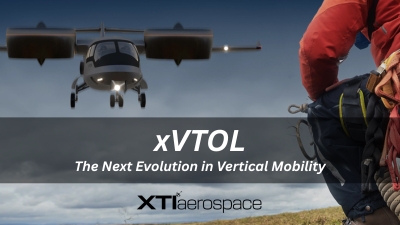Investors are pouring billions into next-gen aircraft—but what if the real breakthrough isn’t electric? It’s expansion.
For years, electric VTOLs (eVTOLs) have been the spotlight in advanced air mobility—sleek aircraft designed for short, air-taxi-like hops across crowded cities. They’ve captured headlines and raised capital, but they represent only part of what’s possible.
Now, a new category is emerging—one built not just for cities but also for the real world.

Introducing xVTOL: aircraft that take off like a helicopter, fly like an airplane, and reach places neither eVTOLs nor traditional planes can go.
Created by XTI Aerospace, xVTOL is engineered for regional missions that move people, businesses, and critical services across hundreds of miles. It’s faster, it goes farther, and it’s in active development.
This isn’t a tweak to the eVTOL concept. It’s a bold redefinition of what vertical flight can do.
What is xVTOL?
xVTOL connotes eXtended-range, eXtended-speed, and eXpanded-mission vertical takeoff and landing aircraft. It’s power source does not define it—it’s defined by what it enables.
These aircraft are designed to solve real-world transportation problems: longer distances, larger payloads, unpredictable conditions, and limited infrastructure. They combine the vertical agility of helicopters with the reach and performance of fixed-wing aircraft. No vertiports required. No compromise on speed or comfort.
Our flagship aircraft is at the center of this new category: the TriFan 600.
Why xVTOL, and Why Now?
We didn’t arrive at xVTOL by accident. We spent years exploring the all-electric and hybrid-electric pathways before deliberately choosing a more strategic, staged approach.
Here’s why:
- Battery technology today—and in the foreseeable future—cannot support high-speed, long-range missions. Even with projected 4% year-over-year battery technology improvements, the gap remains too large.
- We rigorously tested hybrid-electric concepts, including turbine-battery and turbine-hydrogen fuel cell combinations. But immature technologies, undefined regulatory pathways, and absent infrastructure pushed timelines too far out.
- We chose a measured, proven solution: twin-turbine engines that can operate on 100% sustainable aviation fuel (SAF), reducing lifecycle emissions by up to 80%. This allows for faster time-to-market without sacrificing long-term sustainability goals.
- Sustainability remains core to our roadmap. Our phased propulsion strategy is designed to adapt as technology and infrastructure develop.
This is a de-risked program, designed to deliver value now while keeping the door open for future innovation.
The TriFan 600: The Flagship of xVTOL
Our flagship aircraft defines the xVTOL category:
- Cruise Speed: 311 mph
- Range: Up to 985 miles
- Payload: 7 occupants in a quiet, jet-class cabin
- Operations: VTOL from helipads, rooftops, grass fields—or conventional takeoff when available
- Powerplant: Twin-turbine engines powered by SAF
The TriFan 600 is designed for real missions—business aviation, medical transport, defense, logistics—where range, speed, payload, and reliability matter.
What Makes xVTOL Different?
While eVTOLs are optimized for short-range, all-electric flights within urban centers, xVTOL platforms are built for performance across regions—serving markets where infrastructure is limited and mission requirements are non-negotiable.
xVTOL advantages include:
- 2–3x the range and speed of helicopters
- No need for vertiports or charging networks
- All-weather, real-terrain access and operations
- Immediate emissions reduction with SAF and future flexibility to adopt hybrid or electric
Where eVTOL excels in city-center connections, xVTOL opens up the rest of the map.
A Market-Ready Opportunity
This is not just a vision. The XTI TriFan is a program in motion.
- 140+ conditional purchase orders
- 154 additional reservations/options
- $3 billion in potential revenue
- A leadership team built from aerospace leaders at Cessna, Lockheed Skunk Works, Collins Aerospace, and others
- A capital strategy combining public, private, and strategic investment
Investors aren’t just backing an idea—they’re joining a movement with momentum.
Complementing eVTOL, Expanding the Market
We are aligned with the eVTOL mission. But where eVTOLs focus on clean, intra-city mobility, xVTOL expands access to underserved regional airports, remote communities, and cross-state corridors.
Key use cases include:
- Business travel between cities like San Diego and Phoenix, Atlanta and Nashville, Denver and Bentonville
- Emergency medical transport in all-weather, off-airport conditions
- Replacing aging turboprops and short-haul regional flights
- Supporting government and defense operations with flexible VTOL access
This is about mission readiness, not just market potential.
The Future Is Vertical—and It’s Expanding
We coined the term xVTOL to give this new class of aircraft a clear identity—and to lead a global conversation about what’s truly next in powered-lift innovation.
The “x” stands for:
- eXtended range
- eXpanded access
- eXceptional performance
- And everything that comes neXt
It’s a platform. It’s a category. And it’s a movement.
🔹 Welcome to xVTOL 🔹
Welcome to the next evolution in vertical mobility
Follow XTI Aerospace as we shape the future of real-world regional flight.
